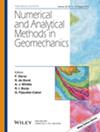Effect of the Variation of Compressibility and Permeability Characteristics of Clogged Stone Column on Drainage Performance of Column During Liquefaction
IF 3.4
2区 工程技术
Q2 ENGINEERING, GEOLOGICAL
International Journal for Numerical and Analytical Methods in Geomechanics
Pub Date : 2025-06-14
DOI:10.1002/nag.70001
引用次数: 0
Abstract
Installation of a stone column (SC) is an effective way to promote radial drainage and reduce the risk of liquefaction. However, the clogging effects caused during the service life of SC result in degradation of the performance of SC. Clogging of SC develops when the water flow force fines to release from soil and migrate with it. These fines may become trapped in the pores of gravel and cause the clogging of SC. The fines accumulation within SC over time not only decrease the permeability of SC, but also increases the compressibility of SC due to the reduction of inter‐particle contact between gravels. The present paper demonstrates a mathematical model to determine the pore pressure of SC‐improved soil during liquefaction by considering the change in permeability and compressibility of clogged SC. The model is validated with the available experimental data. Detail parametric studies are conducted to enhance the understanding of various parameters of soil and SC on the effectiveness of SC due to change in permeability and compressibility of the clogged SC. The results obtained from the present model shows that in the case of multiple earthquakes, for the second earthquake, the pore pressure ratio of SC‐improved ground may increase by more than 36% due to consideration of the compressibility effect of clogged SC.液化过程中堵塞石柱压缩性和渗透性变化对石柱排水性能的影响
安装石柱是促进径向排水和降低液化风险的有效途径。然而,在混凝土使用寿命期间产生的堵塞效应会导致混凝土的性能下降。当水流力从土壤中释放并随其迁移时,混凝土就会发生堵塞。这些细颗粒可能会被困在砾石的孔隙中,导致SC堵塞。随着时间的推移,SC中的细颗粒堆积不仅降低了SC的渗透性,而且由于砾石之间的颗粒间接触减少,还增加了SC的可压缩性。本文建立了一个考虑SC -改良土液化过程中渗透性和压缩性变化的数学模型,并用现有的实验数据验证了该模型的正确性。通过详细的参数研究,加深了对土体和混凝土的各种参数对混凝土的有效性的理解,因为混凝土的渗透性和压缩性发生了变化。本模型的结果表明,在多次地震的情况下,由于考虑了混凝土的压缩性效应,在第二次地震中,混凝土加固地基的孔隙压力比可能增加36%以上。
本文章由计算机程序翻译,如有差异,请以英文原文为准。
求助全文
约1分钟内获得全文
求助全文
来源期刊
CiteScore
6.40
自引率
12.50%
发文量
160
审稿时长
9 months
期刊介绍:
The journal welcomes manuscripts that substantially contribute to the understanding of the complex mechanical behaviour of geomaterials (soils, rocks, concrete, ice, snow, and powders), through innovative experimental techniques, and/or through the development of novel numerical or hybrid experimental/numerical modelling concepts in geomechanics. Topics of interest include instabilities and localization, interface and surface phenomena, fracture and failure, multi-physics and other time-dependent phenomena, micromechanics and multi-scale methods, and inverse analysis and stochastic methods. Papers related to energy and environmental issues are particularly welcome. The illustration of the proposed methods and techniques to engineering problems is encouraged. However, manuscripts dealing with applications of existing methods, or proposing incremental improvements to existing methods – in particular marginal extensions of existing analytical solutions or numerical methods – will not be considered for review.

 求助内容:
求助内容: 应助结果提醒方式:
应助结果提醒方式:


